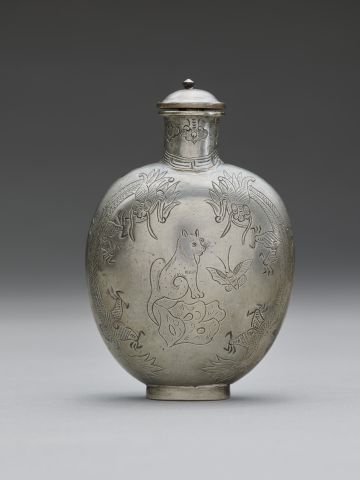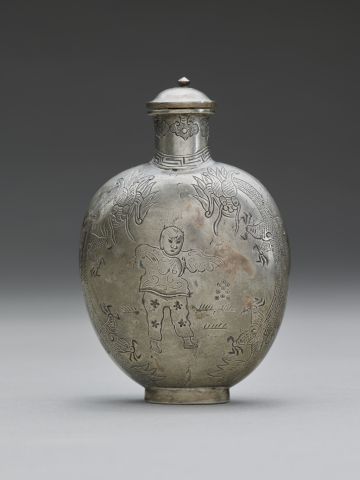

Bottle ID: 718
WHITE COPPER, BAITONG
Date: 1840-1900
Height: 75 mm
White copper (Baitong), of flattened rounded form, with rounded shoulders sloping to a cylindrical neck with an everted mouth and with an oval footrim, cast and incised within vignettes of two dragons, with a child playing with a dragon on one side, the reverse with a cat watching butterflies.
Together with its original matching stopper.
Similar Examples:
Hamilton, Harriet H. Oriental Snuff Bottles, 1977, p.43 and p. 149, no. M7
Low, Denis S. K. More Treasures from the Sanctum of Enlightened Respect. Hong Kong: Denis S. K. Low, 2002, p. 311, no. 283
Moss, Hugh, Victor Graham and Ka Bo Tsang. A Treasury of Chinese Snuff Bottles. The Mary and George Bloch Collection, Volume 7, part 2, Organic, Metal, Mixed Media, Hong Kong: Herald International Ltd., 2009, pp. 379-381, no. 1622 and pp. 382-383, no. 1623
Provenance:
Vincent Fraysse, Paris, France, December 15, 2015, lot 54
Jacques Servier, Paris, France
Viviane Jutheau, 1984
John Ford, Baltimore, MD, 1982
Edward Choate O'Dell
Published:
John Gilmore Ford. Chinese Snuff Bottles; The Edward Choate O'Dell Collection, The Asia House Gallery, NYC, November 1982, no. 899
Bottles such as these, made in the second half of the nineteenth century could have been produced in any location that made crafts such as this in China. The southern name for "white copper" is Paktong with Baitong being the Mandarin or northern term (more widely used today). These bottles are generally constructed in sections and soldered together, sometimes in four sections such as this example, but occasionally in five or six sections. Paktong or Baitong is an alloy of copper, nickel and zinc. In Europe it was known as a subsitute for silver and was called nickel silver. In Harriet Hamilton's book it is referred to as "copper - damascene type...". Its attraction, apart from being inexpensive, was that its surface was conveniently quite soft, allowing for the use of the 'iron-brush technique' as a decorative feature, providing a painterly scene on the two main surfaces of the bottle. It is clear however that this is not the handiwork of a literatus or scholar but rather of a commercial craftsman. A further appealing feature of this bottle is the retention of its original matching stopper.
< Back to full list
 English
English 中文
中文